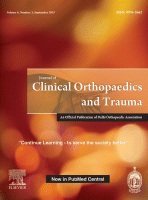
Sports Medicine
No difference in functional outcomes between BPTB and hamstring grafts in ACL reconstruction
J Clin Orthop Trauma. 2019 May-Jun;10(3):581-585.42 patients with complete anterior cruciate ligament (ACL) tears were randomized to receive an ACL reconstruction with either a quadrupled hamstring tendon (QHT) graft (semitendinosus and gracilis tendon) or a bone-patellar tendon-bone (BPTB) graft. Outcomes of interest included functional outcomes measures (Lysholm, Cincinnati scores), anterior knee pain, and instability assessments (Lachman, anterior drawer and pivot shift tests). Follow up was performed at 2 weeks, 6 weeks, 3 months, 6 months and 1 year. No significant differences were observed in both Lysholm and Cincinnati scores at 2 weeks, 6 weeks, 3 months, 6 months and 1 year post-operation. However, significant differences in several Cincinnati sub-scores (pain, overall activity level, running activity) were observed between the two groups. The proportion of patients who reported anterior knee pain was similar between the two groups. Similarly, the proportion of patient who reported altered sensation over the anterolateral aspect of the proximal leg was not significantly different between groups. Lachman test, anterior drawer test and pivot shift test results were similar between groups.
Unlock the full article
Get unlimited access to OrthoEvidence with a free trial
Start TrialCritical appraisals of the latest, high-impact randomized controlled trials and systematic reviews in orthopaedics
Access to OrthoEvidence podcast content, including collaborations with the Journal of Bone and Joint Surgery, interviews with internationally recognized surgeons, and roundtable discussions on orthopaedic news and topics
Subscription to The Pulse, a twice-weekly evidence-based newsletter designed to help you make better clinical decisions
Exclusive access to original content articles, including in-house systematic reviews, and articles on health research methods and hot orthopaedic topics
Or continue reading this full article
Register Now

Subscribe to "The Pulse"
Evidence-Based Orthopaedics direct to your inbox.




































